You need great developers. You also need to manage costs. That’s why offshore hiring looks tempting. You get skilled engineers at a lower price. Sounds perfect, right? But here’s the catch—hiring offshore is not just about cutting costs. It’s about finding the right talent, avoiding risks, and making sure your project doesn’t crash and burn.
Many companies mess this up. They rush in, hire cheap developers, and then wonder why things go wrong. Poor communication. Missed deadlines. Low-quality code. Offshore hiring can work, but only if you do it the right way.
This guide will show you exactly how to do that. We’ll cover everything:
- Where to find the best offshore developers
- How much you should actually pay
- The biggest mistakes companies make (and how to avoid them)
- Legal and security risks you need to know
- How to manage an offshore team like a pro
By the end, you’ll know more about offshore hiring than 90% of business owners. You’ll be ready to build a strong, productive offshore team that actually delivers results.
Next Up: What is Offshore Hiring?
Before we jump into the how, let’s get clear on the what. What does offshore hiring actually mean? How is it different from other hiring models? Let’s break it down.
What is Offshore Hiring?
Hiring offshore means building a team in another country. The developers work remotely, but they are not freelancers. They are dedicated team members, just like your in-house staff. The only difference? They are sitting thousands of miles away.
Offshore vs. Nearshore vs. Onshore – What’s the Difference?
- Offshore – You hire developers in a different country, usually with lower labor costs. Example: A US company hiring developers in India.
- Nearshore – You hire in a nearby country with a similar time zone. Example: A US company hiring in Mexico.
- Onshore – You hire developers within your own country. Example: A US company hiring in New York.
So why do companies prefer offshore hiring over nearshore or onshore? Simple: Cost and talent availability. You get top developers for half the price of an in-house team.
Next Up: Is Offshore Hiring Worth It?
Now that you know what offshore hiring means, let’s talk about the real pros and cons. When does it work? When does it fail? And how do you make sure you don’t regret it? Let’s dive in.
Pros & Cons of Offshore Developer Hiring
| Factor | Pros (✅ Why It Works) | Cons (❌ Potential Risks) |
| Cost Savings | Offshore developers cost 50-70% less than hiring locally. | Cheap rates can mean low quality if you don’t hire carefully. |
| Access to Global Talent | Wider talent pool with top developers available worldwide. | Harder to verify skills compared to local hiring. |
| Faster Hiring Process | Avoid long recruitment cycles and scale teams quickly. | Onboarding can take longer due to remote collaboration. |
| 24/7 Productivity | Different time zones allow for work to continue round the clock. | Time zone gaps can delay responses and meetings. |
| Flexibility & Scalability | Easily scale up or down as project needs change. | Managing remote teams requires extra effort. |
| Reduced Overhead Costs | No office space, equipment, or in-house benefits needed. | Offshore teams may not feel as connected to company culture. |
| Specialized Expertise | Access niche skills not always available locally. | Cultural differences can affect work styles and communication. |
| Legal & Compliance Risks | Can be structured to follow international labor laws. | Different IP laws and compliance issues in each country. |
| Innovation & Fresh Perspectives | Offshore teams can bring new ideas and diverse approaches. | Managing expectations and maintaining quality can be tough. |
Next Up: How to Hire Offshore Developers (Step-by-Step Guide)
We’ve covered the pros and cons. Now, let’s get into the real process. How do you actually hire the right offshore developers without getting burned? Step-by-step guide coming up next.
How to Hire Offshore Developers – Step-by-Step
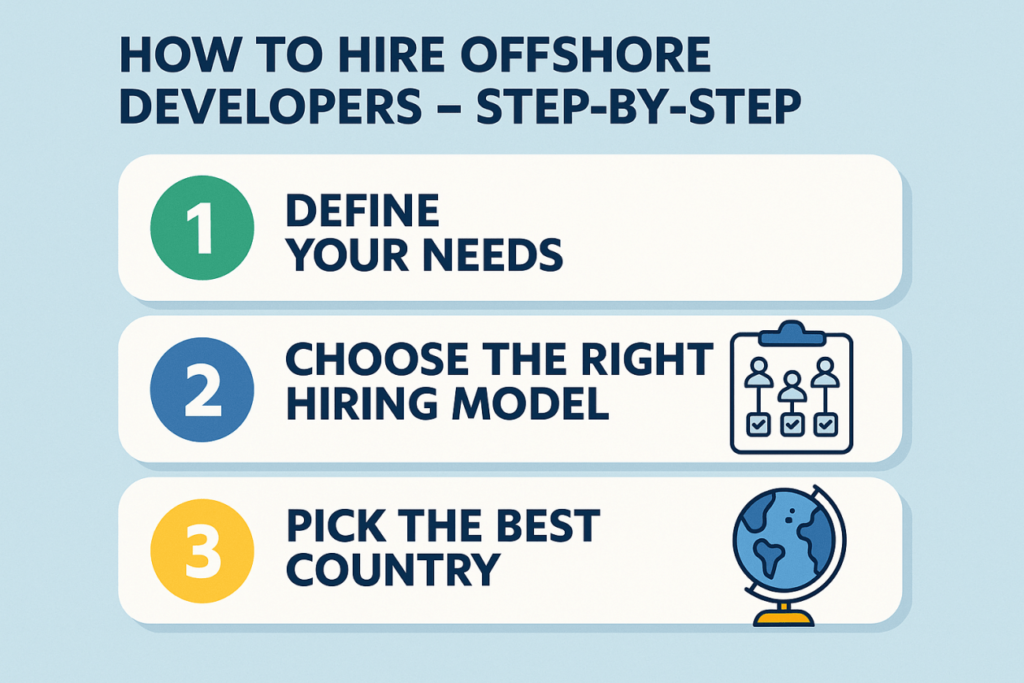
Step 1: Define Your Needs
Before you start searching for developers, get clear on what you need.
- Do you need backend, frontend, or full-stack developers?
- Do you want to hire individuals or a full team?
- What tech stack do you require?
Step 2: Choose the Right Hiring Model
You have three options:
✅ Staff Augmentation – Hire offshore developers to work with your in-house team.
✅ Dedicated Team – Hire a full offshore team that works only on your projects.
✅ Project Outsourcing – Give the entire project to an offshore software company.
Each model has its own pros and cons. Choose based on your project needs.
Step 3: Pick the Best Country
Not every country is good for offshore hiring. Some are cheap but unreliable. Others have great talent but higher costs.
Here are the best countries for offshore development in 2025:
- India – Top choice for affordable, skilled developers
- Ukraine – Best for high-quality engineering talent
- Poland – Great for enterprise software development
- Philippines – Ideal for English-speaking remote teams
- Latin America – Close time zone for US companies
Next Up: How to Ensure Productivity in an Offshore Team
Hiring offshore isn’t enough. You need to make sure your team actually delivers. Next, we’ll cover how to manage offshore teams without losing your sanity.
How to Ensure Productivity in an Offshore Team
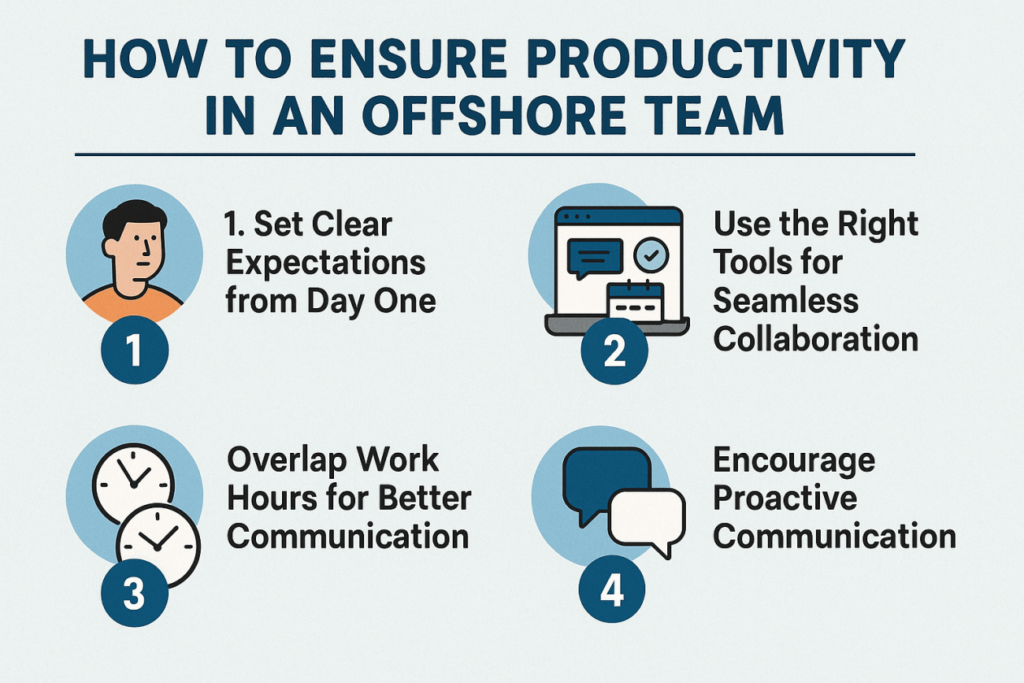
You hired offshore developers. Now what?
Many companies think the job is done after hiring. Then, three months later, they wonder why nothing is getting done. Code is buggy. Deadlines are missed. The offshore team feels disconnected.
This happens because offshore teams need structure. Remote work isn’t magic. You have to set the right processes, tools, and expectations to make it work.
Here’s how to keep your offshore team productive from day one.
1. Set Clear Expectations from Day One
Your offshore developers can’t read minds. If you don’t set expectations early, you’ll spend weeks fixing mistakes.
Define everything before work starts:
✅ What success looks like (KPIs, deadlines, deliverables)
✅ How communication will work (Slack, Zoom, async updates)
✅ Coding standards (version control, documentation, code reviews)
Without this clarity, your offshore development team will guess their way through—and you won’t like the results.
2. Use the Right Tools for Seamless Collaboration
Managing an offshore software development team? Then you need tools that keep everyone aligned.
Here’s what works:
- Slack – Real-time messaging for quick questions
- Zoom or Google Meet – Weekly check-ins
- Jira or Trello – Task tracking
- GitHub or GitLab – Code collaboration
- Notion or Confluence – Documentation
The right tools eliminate confusion. Your offshore developers should always know what’s expected, what’s next, and how to ask for help.
3. Overlap Work Hours for Better Communication
Time zones can make or break your project.
If your offshore development team is 10+ hours ahead, waiting for answers will kill productivity. Developers won’t know what to do next, and projects will slow down.
Solution? Overlap at least 3-4 work hours every day.
✅ If you’re in the US and hiring in India, start meetings early.
✅ If you’re in Europe and hiring in Latin America, set afternoon calls.
This makes sure issues get resolved fast—not 24 hours later.
4. Encourage Proactive Communication
Many offshore developers come from cultures where pushing back is uncommon. If you don’t ask them to speak up, they won’t tell you when something is wrong.
Fix this by:
✅ Asking for feedback often (“What’s slowing you down?”)
✅ Praising questions & suggestions
✅ Making one person responsible for offshore coordination
When offshore developers feel comfortable raising concerns, problems get fixed early—before they turn into disasters.
Next Up: Challenges of Offshore Hiring & How to Overcome Them
Even with the right setup, offshore hiring comes with challenges. Communication gaps, missed deadlines, quality control—these are real problems. But they’re also fixable.
Let’s break them down.
Challenges of Offshore Hiring (And How to Overcome Them)
Some companies nail offshore hiring. Others fail miserably. The difference? How they handle challenges.
Here are the biggest problems companies face when hiring offshore developers—and how to solve them.
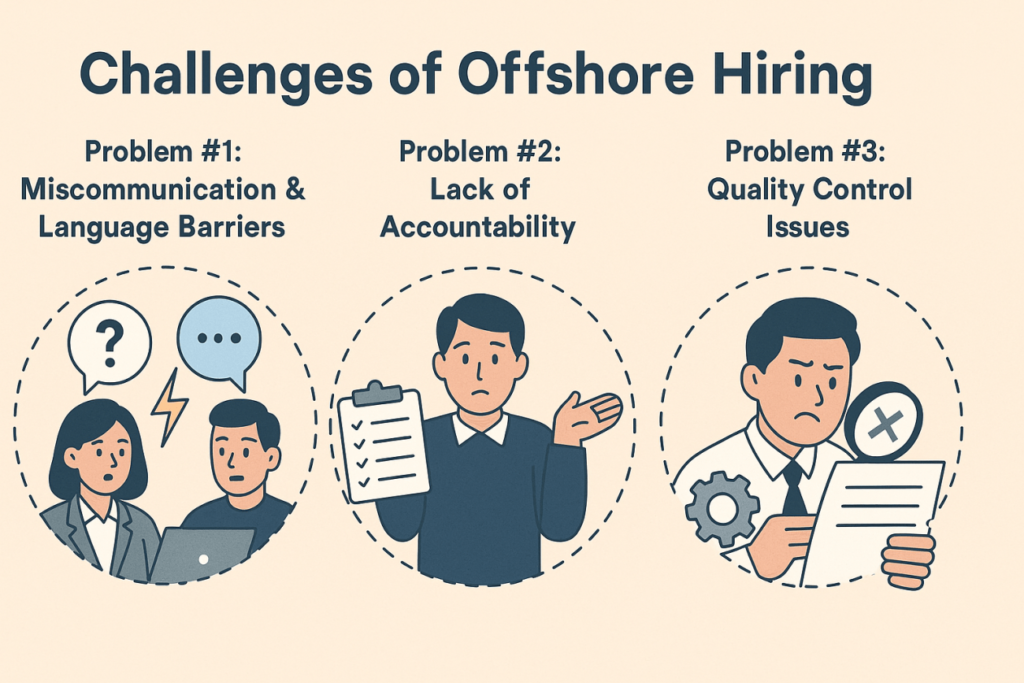
Problem #1: Miscommunication & Language Barriers
Not every offshore developer is fluent in English. A simple misunderstanding can delay projects for weeks.
Solution:
✅ Test communication skills before hiring (not just coding skills)
✅ Use written communication for complex topics (emails, documents)
✅ Encourage developers to ask clarifying questions
Problem #2: Lack of Accountability
Remote teams sometimes feel disconnected. Without oversight, developers miss deadlines or skip quality checks.
Solution:
✅ Use project management tools (Jira, Trello)
✅ Track progress with daily or weekly check-ins
✅ Set clear consequences for missed deadlines
Problem #3: Quality Control Issues
You pay for clean, maintainable code. But some offshore software developers deliver rushed, low-quality work.
Solution:
✅ Conduct code reviews every week
✅ Use automated testing tools
✅ Give detailed feedback on bad code
Next Up: Best Countries for Hiring Offshore Developers
Hiring offshore is only smart if you pick the right country. Some have great talent. Others are cheap but unreliable.
Let’s compare the top offshore hiring destinations.
Best Countries for Offshore Developer Hiring in 2025
Not all offshore teams are created equal. If you hire in the wrong country, you’ll waste money, time, and energy.
Here’s where you’ll find the best offshore developers in 2025:
🇮🇳 India – The Offshore IT Powerhouse
✅ Best for: Cost-effective developers with strong technical skills
✅ Hourly rate: $20–$40
✅ Pros: Huge talent pool, experienced in outsourcing
✅ Cons: Time zone difference with the US
🇺🇦 Ukraine – Top Choice for High-Quality Development
✅ Best for: Complex projects (AI, blockchain, SaaS)
✅ Hourly rate: $30–$60
✅ Pros: Strong engineering education, EU-friendly time zone
✅ Cons: Higher costs than Asia
🇵🇱 Poland – Best for Enterprise Software Development
✅ Best for: Large-scale, long-term projects
✅ Hourly rate: $40–$80
✅ Pros: EU regulations, high English proficiency
✅ Cons: More expensive than India & Ukraine
🇵🇭 Philippines – Best for English-Speaking Teams
✅ Best for: Customer support, front-end development
✅ Hourly rate: $15–$30
✅ Pros: Fluent English, strong work ethic
✅ Cons: Smaller tech talent pool
🇲🇽 Latin America – Best for US Companies
✅ Best for: US startups needing close time zones
✅ Hourly rate: $30–$70
✅ Pros: Cultural similarity, fewer time zone issues
✅ Cons: Higher costs than Asia
What Affects Offshore Developer Rates?
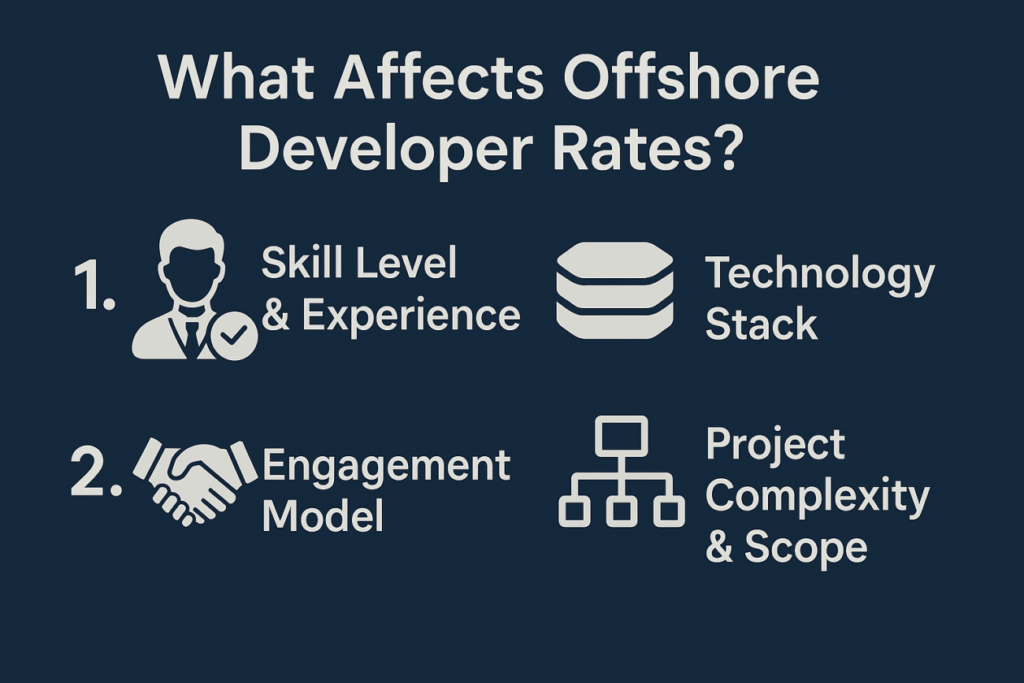
1.Skill Level & Experience
A junior offshore developer will cost less than a senior software engineer.
✅ Junior Developer (0-2 years experience): $15–$30/hr
✅ Mid-Level Developer (3-5 years experience): $30–$60/hr
✅ Senior Developer (5+ years experience): $60–$100/hr
2. Technology Stack
Not all programming languages cost the same. Some require niche expertise, so developers charge higher rates.
Lower-cost skills: PHP, WordPress, basic front-end development
Mid-range skills: JavaScript (React, Node.js), Python, Java
High-cost skills: AI, blockchain, machine learning, cybersecurity
3. Engagement Model (How You Hire)
There are three ways to hire offshore developers:
✅ Freelancers (Lowest cost, but risky)
✅ Dedicated Offshore Teams (Best for long-term projects)
✅ IT Outsourcing Firms (Most expensive, but full project management)
Each model has trade-offs. Freelancers cost less, but you’ll manage everything yourself. A dedicated offshore teamgives more stability but costs a bit more.
4. Project Complexity & Scope
A simple app with basic features will cost less than a high-performance fintech or SaaS platform.
🔹 Basic Web App (MVP): $10,000 – $30,000
🔹 Mid-Sized SaaS Product: $50,000 – $100,000
🔹 Enterprise Software Solution: $150,000+
🚨 Hidden Costs to Watch Out For
Some offshore hiring costs aren’t obvious. Here’s what companies often forget to budget for:
⚠️ Onboarding Time: New developers take weeks to ramp up
⚠️ Time Zone Delays: Slower response times affect project speed
⚠️ Code Refactoring: Cheap developers often deliver messy code
⚠️ Security & Compliance: Some countries lack strict data protection laws
These factors can eat into your savings if you’re not careful.
🔍 So… How Much Should You Pay for Offshore Development?
If you want quality without overpaying, follow these benchmarks:
- Entry-Level Developers: $20–$30/hr
- Experienced Engineers: $40–$70/hr
- Senior & Specialized Roles: $70–$100/hr
- Dedicated Offshore Teams: $5,000–$15,000/month
If someone quotes below these ranges, it’s probably too good to be true. Cheap offshore development often leads to delays, rewrites, and unexpected costs.
Next Up: How to Choose the Best Offshore Development Partner
Now that you know what offshore hiring costs, the next question is: how do you find the right developers?
Not all offshore teams are equal. Some deliver top-tier software, while others cause endless frustration.
Let’s break down how to choose a reliable offshore development partner—so you hire the best team, not just the cheapest one.
How to Choose the Best Offshore Development Partner
Hiring offshore developers isn’t just about finding the cheapest option. It’s about choosing a partner you can trust—one that delivers high-quality code, meets deadlines, and communicates well.
A bad choice means missed deadlines, buggy software, and wasted money. A good choice means scalable, efficient development.
Here’s how to pick the right offshore development partner without regrets.

✅ Step 1: Define Your Needs Clearly
Before you start looking, be 100% clear on what you need. This will filter out companies that aren’t a good fit.
🔹 What’s the project scope? (MVP, SaaS, enterprise software?)
🔹 What technologies do you need? (React, Node.js, Python?)
🔹 Do you need a dedicated team or just extra developers?
🔹 What’s your budget range?
The more specific you are, the better your chances of finding the right team.
✅ Step 2: Shortlist Reliable Offshore Companies
Not all offshore firms are equal. Some promise everything but deliver nothing.
Here’s how to shortlist the best:
🔍 Check Their Portfolio – Have they built projects similar to yours?
📝 Read Client Reviews – Look at Clutch, Trustpilot, and Google Reviews.
🎤 Ask for Case Studies – See how they’ve handled real-world challenges.
🌍 Consider Their Location – Some countries have stronger IT talent than others.
A company without proof of past work isn’t worth your time.
✅ Step 3: Test Their Communication & Culture
Offshore teams shouldn’t feel offshore. You need a partner that’s easy to work with, not one that disappears for days.
Before signing a contract, test their communication:
📅 Schedule a Call – Do they understand your needs clearly?
📢 Check Response Times – Do they reply within hours or take days?
📊 Ask About Their Process – How do they handle delays, bugs, and feedback?
If they struggle to communicate now, imagine the frustration midway through development.
✅ Step 4: Start with a Small Pilot Project
Never commit to a big contract upfront. Instead, test them first.
🔹 Assign a small project (1-2 weeks)
🔹 Evaluate code quality, speed, and professionalism
🔹 See if they follow best practices
If they deliver well, you can trust them with bigger work. If not, you just saved yourself months of headaches.
✅ Step 5: Ensure Security & Legal Protection
Some offshore firms cut corners on security. You need legal protection to avoid data leaks or IP theft.
🛡 Sign an NDA (Non-Disclosure Agreement)
📝 Define Code Ownership in the Contract
🔒 Check Their Data Security Standards
Never assume they’ll handle security correctly—make it a requirement.
Next Up: The Future of Offshore Development – Trends to Watch
Offshore hiring is evolving fast. AI, automation, and new global policies are changing the landscape.
In the next section, we’ll explore what the future holds for offshore development—and how you can stay ahead of the curve.
The Future of Offshore Development – Trends to Watch
Offshore development is not what it was five years ago. It’s evolving fast. New technologies, shifting global markets, and changing business needs are shaping the future.
If you plan to hire offshore developers in the coming years, you need to stay ahead of these trends.
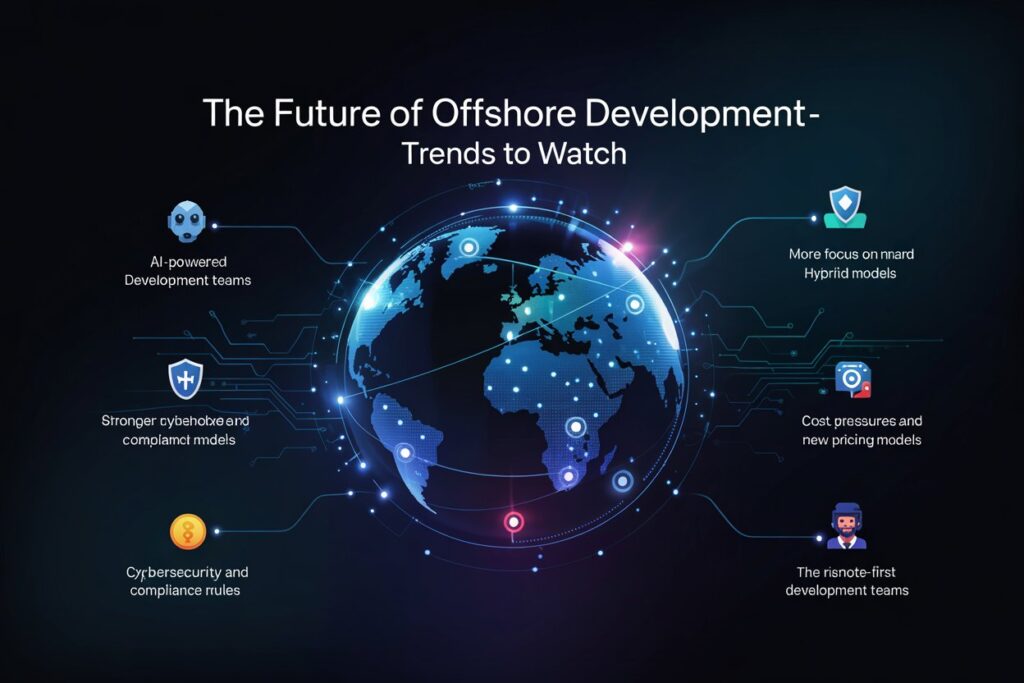
Let’s look at what’s coming next.
🚀 Trend #1: AI-Powered Development Teams
AI is already transforming software development. But it’s not replacing offshore developers—it’s making them faster, smarter, and more efficient.
🔹 AI-powered code assistants (like GitHub Copilot) help offshore teams write code 50% faster.
🔹 AI-driven project management tools improve task tracking and bug detection.
🔹 Companies are hiring offshore developers who know how to use AI effectively.
In the future, the best offshore teams won’t just write code—they’ll use AI to supercharge development.
🌍 Trend #2: More Focus on Nearshore and Hybrid Models
Offshore development used to mean hiring teams on the other side of the world. That’s changing.
🔹 Companies are choosing nearshore teams (closer time zones, better communication).
🔹 Hybrid models (a mix of offshore and in-house teams) are becoming more common.
🔹 Businesses want faster response times and fewer cultural barriers.
Offshore isn’t disappearing—it’s just becoming more strategic.
🛡 Trend #3: Stronger Cybersecurity and Compliance Rules
Data security is a top concern when hiring offshore. Governments and businesses are tightening regulations.
🔹 Companies now require offshore teams to follow strict security protocols.
🔹 New compliance laws (GDPR, CCPA, and others) impact where and how you hire.
🔹 Secure coding practices, encrypted communication, and cybersecurity audits are now standard.
The best offshore teams will invest in security-first development.
💰 Trend #4: Cost Pressures and New Pricing Models
Offshore hiring was always about cost savings. But now, wages in top outsourcing hubs (India, Ukraine, Latin America) are rising.
🔹 Companies are looking at tier-2 cities for more affordable talent.
🔹 Outcome-based pricing (paying for results, not hours) is gaining traction.
🔹 Remote work is leveling the playing field—some offshore developers now charge the same as local developers.
Finding quality offshore talent at the right price will require smarter hiring strategies.
👨💻 Trend #5: The Rise of Remote-First Development Teams
Companies now realize they don’t need a physical office to build great software.
🔹 Offshore teams are becoming fully integrated into company cultures.
🔹 More businesses are adopting remote-first policies for seamless collaboration.
🔹 Cloud-based tools (Slack, Notion, Jira) make remote development easier than ever.
Hiring offshore is no longer just outsourcing—it’s becoming a normal way to build tech teams.
Final Thoughts: What This Means for You
Offshore development is not dying—it’s evolving. The future belongs to companies that adapt.
To stay ahead, you need to:
✅ Hire offshore teams that leverage AI and automation.
✅ Focus on nearshore or hybrid models for better collaboration.
✅ Choose developers who prioritize security and compliance.
✅ Use smarter pricing models to get the best value.
✅ Build a remote-first culture that integrates offshore talent.The companies that understand these trends will win in the next 5-10 years. The ones that ignore them? They’ll struggle.






No Comment! Be the first one.